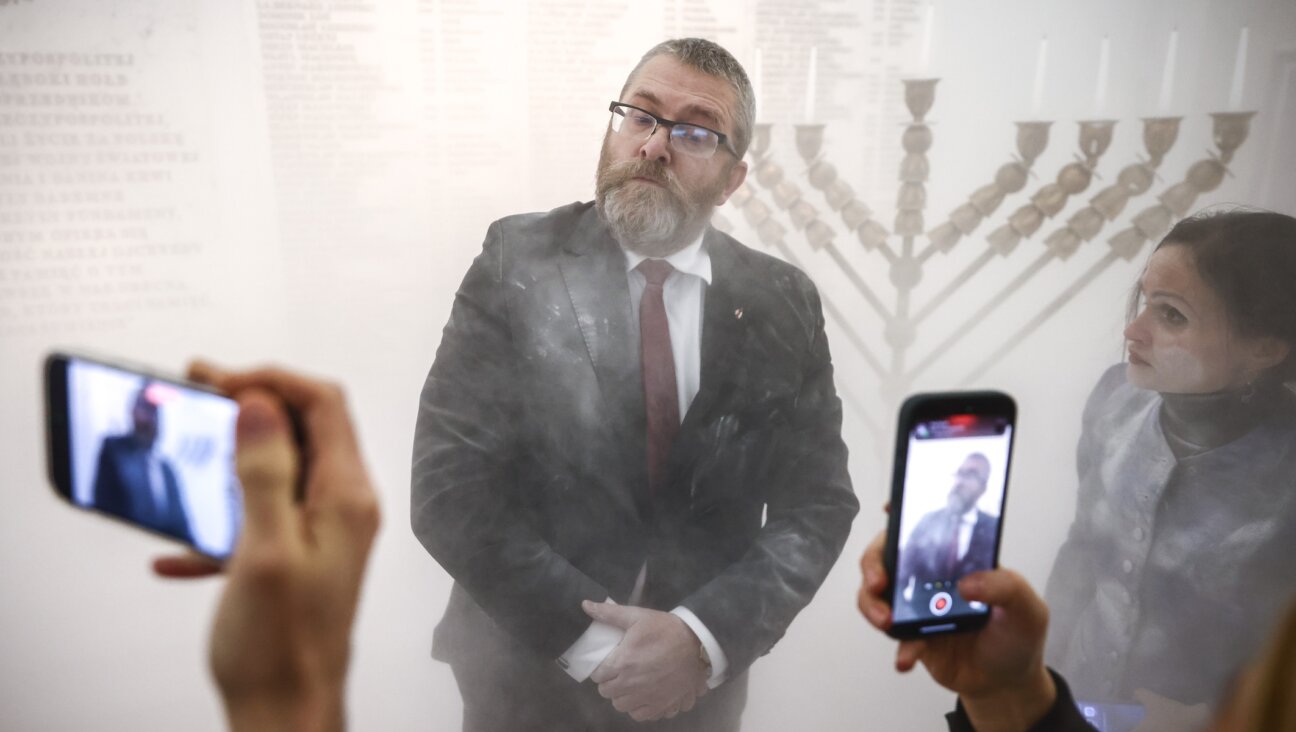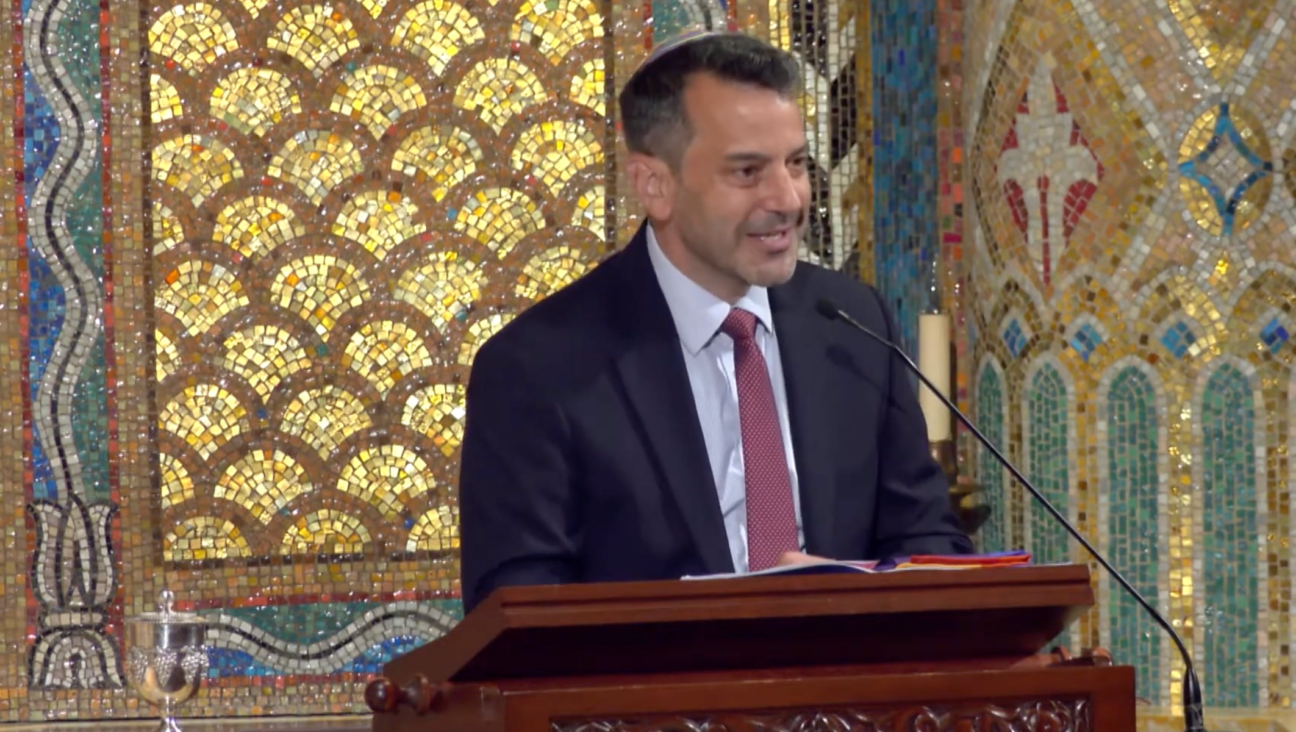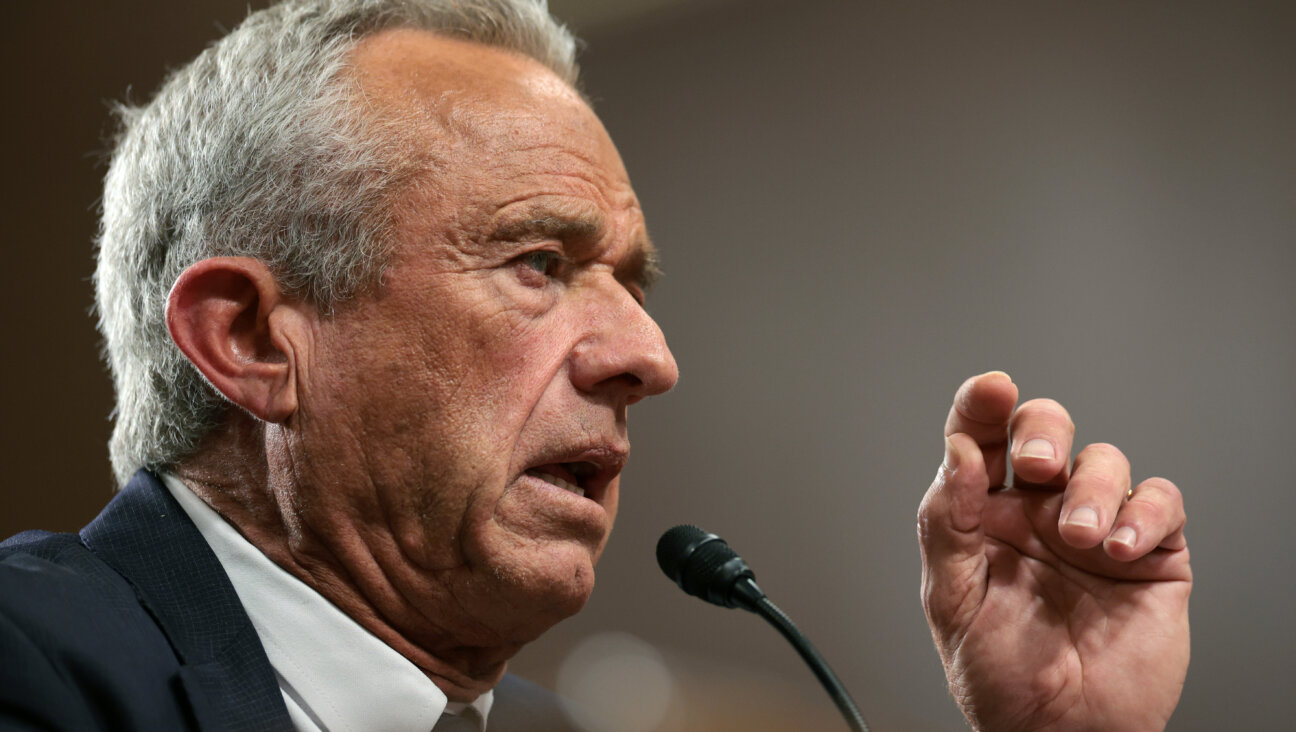Part II: Writing in My Father’s Footsteps

Israel?s history underfoot in New York: This Haganah plaque is on the sidewalk of East 60th street in the heart of Manhattan just outside the Rouge Tomate restaurant, formerly Hotel Fourteen where the Haganah was based. Image by JON KESSELMAN
When my father was 9, his mother, Bessie, developed cancer. At the age of 12, my father returned home from school to find all the mirrors in his home covered; Bessie had passed away, and my father was told by his father, Bennie, a fruit salesman, that Bessie had died because my father had been “bad.” Bennie decided he could not care for his son, and for five years my father was passed around from relative to relative.
My father spent a great deal of time with the Spiegels and formed a very close bond, in particular with his aunt Bessie Kesselman, who ironically had the same name as his deceased mother. While fighting in Europe, Aunt Bessie’s son Danny died in a tank battle. This shook my father to the core, and it was then that he decided to enlist to fight in the Second World War; he was 17.
In 1945, my father arrived in Italy: a trained soldier without a battle to fight. From Italy he was transferred to the Pacific and, as luck would have it, missed combat there, as well. Soon he returned to his home in the Crotona Park neighborhood of the Bronx. While he was alive, I never took the opportunity to ask my father how or why he went to fight for Israel: whether out of hope or rage, or just because he was asked. What I did do is ask some of the people who may not have known him but nonetheless walked alongside him.
Norman Shutzman, who was to become my father’s commanding officer in Palestine, had been a soldier in the U.S. Army for four years; he fought in an anti-aircraft unit in the Pacific in 1942, and then retrained to subsequently fight for the infantry in France and Germany. When Shutzman returned home to Wilmington, Del., with the rank of captain, he had seen enough; he was done fighting. He threw away his uniform, his medals and anything that reminded him of the war. Around 1947, however, Shutzman had a life-changing epiphany: A secular Jew who had never been a Zionist, he was galvanized by the thought of what a Jewish state could mean for his people. Suddenly, Shutzman felt that if he did not go and help, he would not be able to live with himself. When he told his parents of his plans to go back to war, they pleaded with him to stay. In fact, the day he left home, his father refused to say goodbye to him.
Not knowing whom to contact, Shutzman reached out to the Jewish federation in Delaware, which encouraged him to travel to New York to obtain more information. It was there that he encountered the Haganah, the Jewish underground group responsible for the illegal smuggling of North American soldiers and armaments into Israel.
Si Spiegelman is the former head of the American Veterans of Israel, an organization formed in 1963 with a stated mission: “To preserve and strengthen a spirit of comradeship among its members; to assist worthy comrades; to perpetuate the memory of our dead and to maintain and extend the institutions of freedom, and to foster good will between the United States of America and Israel.” He did not know Shutzman at the time, but he had reasons of his own for volunteering. Born in Belgium, his family escaped Nazi occupation when he was 12. As the family was fleeing, he recalled his father kicking a member of the Gestapo, who was attempting to arrest the Spiegelmans, off a trolley. The family eventually managed to escape Antwerp through France and Spain, and from Spain Si traveled to Cuba on a cattle freighter. In 1946, his family finally found the way to the United States. Finally “home,” the 16-year-old Si, filled with rage from his family’s ordeal, became active in a Zionist youth movement, and through this organization he eventually began to volunteer for the Haganah.
Though Spiegelman did not know Paul Kaye (Kaminetsky), who in later years came to be one of his closest and oldest friends, Kaye had begun to volunteer for the Haganah around the same time. A native New Yorker, Kaye enlisted in the Army to fight in Second World War upon graduating from Chelsea High School in Manhattan. After finishing boot camp, he became a marine engineer and, as he awaited his first action on a Pacific-bound flotilla, the atomic bomb was dropped and his ship was turned around. Back in the United States, Kaye was demobilized and found himself working in a record shop in New York. One day, he received a strange phone call:
“Paul Kaminetsky, would you like to help your people? We know you’re a marine engineer. If you do want to help your people, be on the corner of 29th and Lexington Avenue, Southeast Corner, 4 p.m., on Thursday. A man in a black leather jacket will be there with a newspaper under his arm. If he puts the newspaper under his arm, follow him. If he puts it into a wastebasket, please leave quickly. It means you’re being followed.” There was a click on the other end of the line as the phone went dead. Kaye was intrigued.
The recruitment of North American soldiers was centered in New York City. An organization known as Land and Labor for Palestine was the legitimate front. Land and Labor sent supplies to Israel very carefully; however, the organization was not allowed to send arms. Most potential recruits and, most likely, my father furtively met with operatives from Land and Labor in Manhattan at the Hotel Martinique, with a run-down French Décor, near 34th Street and Broadway.
After potential recruits were interviewed, they were taken to meet Teddy Kollek, head of the Haganah. Kollek based the Haganah out of Hotel Fourteen, on East 60th Street. The hotel was upstairs from the world-famous Copacabana, where Frank Sinatra, Lena Horne, Jackie Gleason and many other stars of the day performed. As one Machalnik, who requested not to be named, remembered: “For approval to make sure you weren’t infiltrating, you had to see Teddy. I always wondered if Teddy was tired out from all of the showgirls when he saw you, because he was always lying down when you’d meet him. Anyway, you’d come in and he’d look you over, and that was it.”
Kollek later went on to become Jerusalem’s mayor for 40 years, and one of its greatest fundraisers. To this day, outside the Copacabana there is a plaque that reads, “This building sheltered the clandestine mission of the ‘Haganah,’ Israel’s pre-state defense forces, which labored unceasingly for Israel’s independence and survival.”
Danny Greenspun, son of Hank Greenspun, who eventually started the Las Vegas Sun, recalls one story his father told him about Kollek and the Copa. Downstairs, Sinatra would perform at the club, while upstairs, Kollek was running the Haganah. Kollek was having difficulty bribing a captain of a ship filled with arms that needed to be smuggled into Palestine. He ultimately confessed to Sinatra what he was up to, so Sinatra decided to lend a hand and personally delivered the bribe money to the captain. Awed that Sinatra was asking *him *for help, the captain took the bribe, and the ship set sail for Palestine.
At the time, Arabs were allowed to bring arms into Palestine; Jews were not. Kollek enlisted Hank Greenspun and Al Schwimmer, a former U.S. Army Air Force flight engineer, to smuggle arms into Palestine for the Jews. Greenspun, a well-connected Jew in Vegas, enlisted the help of the Purple Gang and such mobsters as Meyer Lansky, Bugsy Siegel and Lucky Luciano. Jimmy Hoffa was also a supporter. People on the street knew it was union practice to drop shipments in a scheme to collect hazard pay, and Hoffa made sure that the teamsters knew never to drop any of the shipments (invariably filled with ammo and arms) bound for Israel.
In July 1950, Greenspun and Schwimmer were convicted of violating the U.S. Neutrality Act, an arms and personnel embargo to the Middle East. The men were fined $10,000, but never saw any jail time. After talking to Kaye and Spiegelman I came to believe that maybe if Greenspun and Schwimmer had not taken the rap, other North American Machalniks would have been arrested when they were home from Israel. In October 1961, President Kennedy pardoned Greenspun, and to this day, there is a park in Jerusalem named after him. In 2000, President Clinton pardoned Schwimmer. and just this past December, President Bush posthumously pardoned Charles Winters, a non-Jewish Englishman who spent 18 months in prison for delivering B-17 bombers to help in the fight.
The Haganah provided most members of Machal, including Kaye and my father, with falsified documents that would allow them to enter Israel. Kaye was reborn a South African with the last name Kaplan. Another Machalnik metamorphosed into David Kampinksy, a carpenter from Bucharest. Schutzman sold his bowling alley, and overnight he became the star flexible joint salesman for Zallea Brothers, one of the largest flexible joint manufacturers in the country.
And in the summer of 1948, my father, whose new name I do not know, held in his hand a brand-new passport as he boarded a decommissioned American warship as a Belgian-lace salesman bound for Marseilles.
What follows is a video that includes interviews of soldiers who fought for Israel as part of Machal.
For part one, click here; for part three, click here. Read part four in the May 8 issue.
Jonathan Kesselman is a screenwriter and film director (“The Hebrew Hammer”), and an adjunct professor at Yale University.
A message from our Publisher & CEO Rachel Fishman Feddersen

I hope you appreciated this article. Before you go, I’d like to ask you to please support the Forward’s award-winning, nonprofit journalism so that we can be prepared for whatever news 2025 brings.
At a time when other newsrooms are closing or cutting back, the Forward has removed its paywall and invested additional resources to report on the ground from Israel and around the U.S. on the impact of the war, rising antisemitism and polarized discourse.
Readers like you make it all possible. Support our work by becoming a Forward Member and connect with our journalism and your community.
— Rachel Fishman Feddersen, Publisher and CEO























